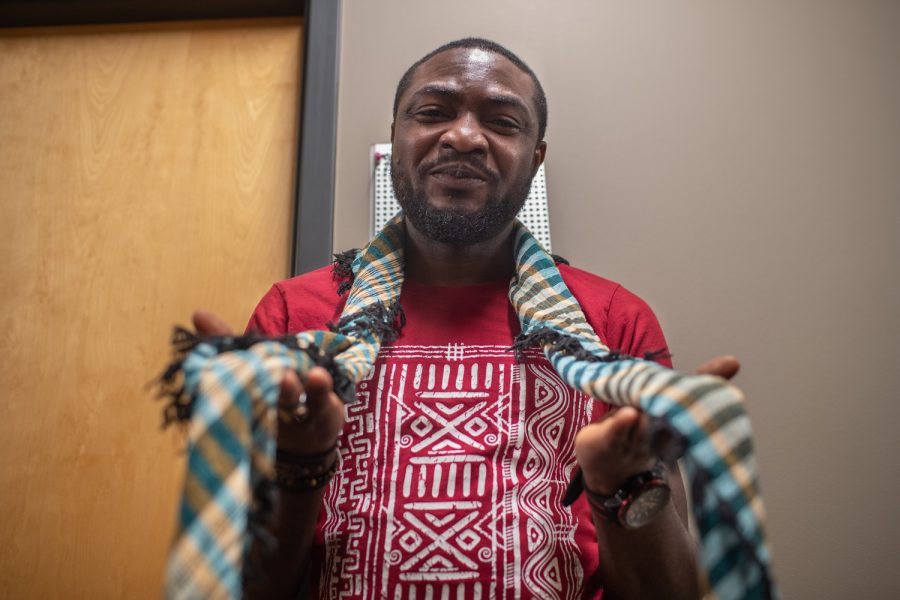UI faculty members share inspirations behind their personal styles
Stylish faculty members at the University of Iowa use their clothes as a form of self-expression and encourage the same from their students when making statements with their own clothing inspirations.
Abubakar Ibrahim holds his scarf while posing for a photo in the Adler Journalism Building on Tuesday, March 7, 2023.
March 7, 2023
When Abubakar Ibrahim threw on a scarf to dress his casual outfit up for a formal occasion, he did not expect the article of clothing to become his iconic fashion statement — but he has since embraced it.
Just like students, instructors at the University of Iowa express themselves in several ways, one of which is through style.
Ibrahim, a second-year graduate student in the journalism program and a teaching assistant for the Freedom of Expression course, said his personal fashion is influenced by a colorful palette, his Nigerian heritage, and the importance of versatility and comfort.
Ibrahim’s style defines his identity differently depending on whom he is interacting with. One of his favorite articles of clothing is a scarf, part of a collection he started building in Nigeria when he was working as a journalist. Since then, people who know him as a journalist cannot disassociate him from his scarves.
“When I post photos on social media, and I don’t have my scarf on, people are like, ‘Where’s your scarf?’” Ibrahim said. “I think that people believe I sleep with my scarves.”
Instead of his scarves, Ibrahim said students at the UI identify him by his shoes, even going so far as to compliment them in course evaluations last year. Ibrahim appreciates the attention he receives as a connoisseur of shoes, but he also found that students’ interest in them could distract from lessons.
“I had this last student who in the middle of class would go, ‘Those are really cool shoes’ in the middle of lessons. So, I tend to want to avoid that,” Ibrahim said.
For the same reason, Ibrahim has leaned away from wearing his kaftan — a type of robe common in Nigeria in formal contexts — because students might be more focused on what he is wearing than what he is teaching.
Regardless of the occasion, Ibrahim makes sure he includes a pop of color in every outfit, a decision he said is inspired by his affinity for color and his Nigerian culture.
Alex Cornejo, a graduate student and teaching assistant for a UI gender and society sociology class, is similarly inspired by the colors of his South American culture.
Cornejo’s style is bright and bold and largely composed of thrifted pieces. Like Ibrahim, his favorite article of clothing is shoes — specifically cowboy boots.
Since high school, Cornejo said his style evolved from American Apparel pieces to completely thrifted outfits to what is typically considered more masculine. His previous fashion choices were often influenced by the opinions of others, he said. It wasn’t until he got to college that he discovered his sense of style.
“So, I was experimenting back and forth with style during college, but it wasn’t anything outrageous,” Cornejo said. “I definitely wouldn’t have worn a heel, even though I was curious about it. And so, toward the end of my undergrad and the beginning of my grad, I was really like, ‘What is stopping me from just wearing what I want on Tuesday?’ And so, then I just started playing with fashion.”
Cornejo is also inspired by TikTok, where he shares his style choices and learns of fashion trends. On the platform, he will often come across content creators who preach individuality while also suggesting that there are only certain acceptable ways to dress.
Instead, Cornejo believes fashion is whatever anyone feels the most confident and comfortable in.
Fashion can also make statements about the social or political atmosphere of the time. Throughout history, clothing has reflected cultural movements, especially ones that impact the way gender is perceived.
For example, as Cornejo pointed out, heels were worn by men of higher socioeconomic status to signify their wealth and superiority over lower-class people in the 17th century. When women began wearing them, men stopped to avoid being perceived as feminine.
“Fashion just keeps evolving,” Cornejo said. “So, this is what I tell my students: You can objectively see that objects, their meaning, changes with time, right? And so, if their meaning changes, is it fixed? And because it’s not fixed, there’s no inherent truth.”
While Cornejo considers his style maximalist, UI rhetoric instructor Tove Conway would call hers minimalist. Conway’s clothing choices are influenced by her interest in environmental studies and sustainability.
“Anything that I’m purchasing or creating, I want to be a long-term decision, something that I can wear for years to come and things that I can wear with any outfit,” Conway said. “Have your style be versatile and not just for one event because then you’re just consuming and scrapping all the time to fit those event’s needs.”
Conway is just as passionate about writing as she is about art and seeks to bring both into her classroom. Her style, which she describes as intentional artfulness, reflects this passion.
Heidi Casto, a UI professor of art, takes a similar approach to her outfits.
“I’m kind of curating an art project for the day,” Casto said. “It’s really important to me to look like an artist — to present myself as a fun person — but at the same time, to wear an outfit that’s very versatile that can go from feeling professional to working in the studio because that’s bouncing around like that all the time.”
Casto’s wardrobe consists of clothing she found while thrifting and pieces her mother, a seamstress, made. Her students engage with her by asking her about these pieces and sharing their appreciation for them.
“I think that, in the arts, it’s very common to just really appreciate each other’s style,” Casto said. “And because we are all alike, it’s all about color and shapes. It’s another form of art, so an extension of our personalities. So, I think that we all really appreciate what’s put into fashion. And it’s a common conversation amongst the art crew.”
Whether an art professor or a journalism TA, every faculty member has a unique sense of style influenced by their personality and culture. Their styles allow them to connect with students through self-expression and encourage them to be unapologetically themselves.
“I think what you wear is and can be how you think about yourself or a message to the world visually,” Conway said. “I think it should also just be something that you feel yourself. In terms of style: Curate your style to your individual expression rather than consume to fit something that maybe isn’t you exactly.”















